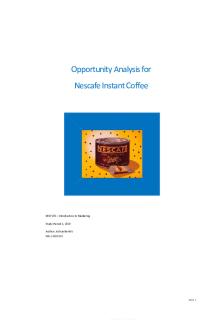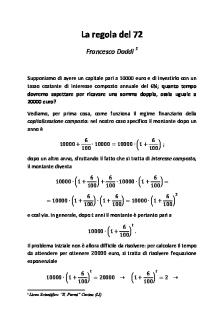7-2 LIT 231 Final Analysis PDF

| Title | 7-2 LIT 231 Final Analysis |
|---|---|
| Course | Nature Writers |
| Institution | Southern New Hampshire University |
| Pages | 6 |
| File Size | 87.6 KB |
| File Type | |
| Total Downloads | 5 |
| Total Views | 192 |
Summary
Assignment...
Description
Mary Oliver’s Correlation Between Emotion & Nature
One of the first and critical themes discussed in Nature Writers was vision of natures and self. How do writers express their perception of their surroundings and self? How can an author effectively merge those two visions together to tell the story about how one connects to nature? One of the first authors introduced to our class was Mary Oliver and initially critiqued ‘The Mango’. It seemed too simple and lacked depth, however it took a couple reads to digest and process Oliver’s message. Which after reading Mary Oliver’s poetry, the reader finds themselves observing a consistent theme of nothing more than raw passion. In Mary Oliver’s ‘The Mango’, There is an ongoing theme of contrast being used throughout the poem. The primary focus is on a woman enjoying a sweet mango. She initially describes the mango appearing as "orange flowers, cubist and juicy". As she is immersed with the sweetness of the mango, she starts noticing she hears things in the background that were not so sweet. Situations occurring in another country and that country being in trouble. Once she mentions hearing "men" and "guns" the reader can gather that the trouble the woman is hearing about is a war going on in another country. In another line, Mary Oliver states “It wasn’t my language, but I understand.” This shows that while all of us (humans) speak different languages, it is the language of emotion that is universal. In one of the final lines, she modifies the description of the mango as tasting like "sharp gravel in the flesh". ‘The Mango’ is a prime example of the literary style that Mary Oliver
has chosen to convey her vision of nature. She is unlike the traditional poet; she does not find it necessary to use vague yet complex language to bury her meaning for the reader to dig up and find. She insists on using simple yet visual language to capture the reader’s attention almost to paint that connection for the reader. For some readers, her style has been compared to a meditation called ‘Buddhist mindfulness’. This meditation has 3 phases: Beginner’s Mind, Mindful Awareness, and Nowness. The purpose of this meditation is to allow to be awakened and self-aware of living in the moment. It is said by that “These three corollaries that the topoi of amazement and loving this world are articulated. The essence of Oliver’s poetry is the feeling it evokes in readers, therefore making it a mindful experience which may be life-changing for them” (Ullyatt 15). With the average poem, they are designed for readers to critically think about the specific literary devices and symbolisms the author utilized to share their story in the most innovative style possible. While it is a good style to write to exercise critical thinking skills, it is not an effective style to evoke any emotion or connection to the actual plot. Not only does Mary Oliver’s visual depictions capture the reader’s attention, but she also includes adequation and correspondence. With her style of switching between descriptions the surroundings of the nature around her and her thoughts on it, this not only makes the attention of the reader captured, but engaged as it mimics a type of conversation, she is having with the reader rather than a narration. This style of writing is beneficial to those who connect with literature in a purely emotional context. “These two apparently divergent impulses, one antisymbolic, the other symbolic, ebb back and forth in the poetry of Mary Oliver. Her ability to integrate them without confusing them yields an original vision of spirit and nature that is both utterly concrete and utterly transcendent.” (Christie-Burton 1). While many praise Mary Oliver for the alternative way of writing poetry, not all agree that this style of poetry is the best way to convey a meaning or evoke
a reader’s emotions. Her style of writing is almost seen as one sided, and that it is excused with decorative language to show this “façade” for her passion of nature. “According to Voros, Oliver's language is unforgivably one-sided, “unwavering” in its “awe” and “visionary ecstasy,” unlike precursors such as Wordsworth or Dickinson who “rely on a firm foundation of the daily against which the visionary rises in shining relief” (233). The problem, Voros maintains, is that despite appearances, Oliver's “passion for transcendence” betrays a fundamental disenchantment with the “human experience as hopelessly paltry … an unforgivable trespass” (Zona 1). While the critic has a valid point that Oliver in fact uses visual language in her poem, that it is nothing deeper than a personal preference of expression. People who are passionate about topics tend to emphasis the passion more than focusing on how they are articulating it. That is what makes their passion raw. Just because the poet does not adhere to the traditional format or rather, the critic thinks that this poet does not adhere to how they think a poem should be written, does not mean that this poet does not know how to write a proper poem. Writing, specifically in formats such as poetry, are designed to constantly test rules and boundaries in favor of expressing emotions. Mary Oliver views nature in a passionate light. In writing, permission should be given to express those connections and emotions in range whether it is a traditional format or an experimental format. Kristen Hotelling Zona, author of “An Attitude of Noticing”: Mary Oliver's Ecological Ethic” clarifies in her notes “ It would be a mistake, however, to sum up this state of affairs via recourse to a scholarly penchant for the sort of “difficult” poetry that Oliver's plain-spoken work appears to eschew; not only does this easy opposition often obscure a parochial or partisan agenda, but, more to the point, it allows us to overlook the ways in which Oliver's poetic resists, and is thus rendered invisible by, interpretive lenses wherein the posture of mindfulness is mistaken for stasis or lack of discrimination.”
(Zona1) Despite the criticism, Mary Oliver makes a clear intention that it is anything but lacking a passion for her connection with nature. She clearly states the intent that readers who read her poems do not read for how she writes her expression but how she expresses her passion and that people are looking for more than just to read but engage in the writing. “When I step onto a stage to read poems, the anticipation and even the hope of the audience is palpable. The people sitting quietly in the chairs – they have come not to rest, but to be awakened” (Ullyatt 15). In another one of Mary Oliver’s poems: ‘ A Dream of Trees’, it is a short, yet profound poem that once again utilizes adequation, correspondence, and visual depiction of connecting art, emotions, and nature. “There is a thing in me still dreams of trees. But let it go. Homesick for moderation, Half the world's artists shrink or fall away. If any find solution, let him tell it. Meanwhile I bend my heart toward lamentation Where, as the times implore our true involvement, The blades of every crisis point the way.
I would it were not so, but so it is. Who ever made music of a mild day?” (Oliver 1)
Similar to ‘The Mango’, She is expressing an immense amount of emotion, particularly sorrow for the lack of attention to the dreams she has instead of balancing dreams with obligations. That it is inevitable that obligations take priority over dreams. When dreamers prioritize obligations, their dreams slowly fade away. She implies towards the end that at the end of the day, dreams take risk, referencing specifically to the last line “Who ever made music of a mild day?” (Oliver 1). “Through the use of these devices, Oliver invites the reader to be more mindful, not of the past or future but of the present moment; ultimately, readers should think about their own lives. The voice speaking in the poem should, or can, imaginatively, become the reader’s inner voice” (Ullyatt 15). The meaning behind Mary Oliver’s ‘I Dream of Trees’ is a subject that resonates immensely universally, which also supports her style of delivering the poem in the flow of a conversation as opposed to a poem that has a meaning that needs to be deciphered. When people are relating to a poem such as ‘I Dream of Trees’, they are taking away more than just relatability to the poem, but a piece of encouragement to take the risk if there is a dream that you are really passionate about. Overall, Mary Oliver successfully expresses her emotions clearly in her poetry in an alternative manner. From a first-time reader’s perspective encountering upon Oliver’s work, it is easy to judge that her writing style appears to almost satire if you do not take in truly what her message is conveying. Her writing style correlates with the practice of Buddhist meditation of mindfulness. It can be said that reading her poems feels as if you are meditating. Taking in her description of nature, her vision that surrounds around her, and how she herself in feeling in the moment in this spiritual connection. It does not appear that Mary Oliver is faking her passion at all. As a reader, her poems leave you feeling more at peace with nature. She is not articulating the connection; she is showing you the connection.
Works Cited: “A Dream of Trees.” Best Poems, www.best-poems.net/mary_oliver/a_dream_of_trees.html. Accessed 12 Dec. 2020. St, Edna. “Figs from Thistles: The Penitent by Edna St.… | Poetry Magazine.” Poetry Magazine, 2020, www.poetryfoundation.org/poetrymagazine/browse?contentId=36385. Kirstin Hotelling Zona, “An Attitude of Noticing”: Mary Oliver's Ecological Ethic, ISLE: Interdisciplinary Studies in Literature and Environment, Volume 18, Issue 1, Winter 2011, Pages 123–142, https://doi-org.ezproxy.snhu.edu/10.1093/isle/isr001 Ullyatt, Gisela. “‘The Only Chance to Love This World’: Buddhist Mindfulness in Mary Oliver’s Poetry.” Journal of Literary Studies, no. 2, 2011, p. 115. EBSCOhost, search.ebscohost.com/login.aspx?direct=true&db=edsggo&AN=edsgcl.264761126&site=edslive&scope=site. Burton-Christie, Douglas. “Nature, Spirit, and Imagination in the Poetry of Mary Oliver.” Cross Currents, vol. 46, no. 1, Spring 1996, p. 77. EBSCOhost, search.ebscohost.com/login.aspx? direct=true&db=hlh&AN=9605020326&site=eds-live&scope=site....
Similar Free PDFs

7-2 LIT 231 Final Analysis
- 6 Pages

LIT-231 Analysis Paper 2
- 3 Pages

Accy 231 final essay
- 31 Pages

Lit 200 Final Project
- 6 Pages

ME-231
- 963 Pages

Opportunity Analysis final final
- 12 Pages

SE 231 Assignment 2
- 4 Pages

Lab01 - cse 231
- 2 Pages

La regola del 72
- 10 Pages

Catullo Carmi 8, 72
- 5 Pages

Lezione 9 - Appunti 72
- 3 Pages

SE 231 Assignment 5
- 4 Pages
Popular Institutions
- Tinajero National High School - Annex
- Politeknik Caltex Riau
- Yokohama City University
- SGT University
- University of Al-Qadisiyah
- Divine Word College of Vigan
- Techniek College Rotterdam
- Universidade de Santiago
- Universiti Teknologi MARA Cawangan Johor Kampus Pasir Gudang
- Poltekkes Kemenkes Yogyakarta
- Baguio City National High School
- Colegio san marcos
- preparatoria uno
- Centro de Bachillerato Tecnológico Industrial y de Servicios No. 107
- Dalian Maritime University
- Quang Trung Secondary School
- Colegio Tecnológico en Informática
- Corporación Regional de Educación Superior
- Grupo CEDVA
- Dar Al Uloom University
- Centro de Estudios Preuniversitarios de la Universidad Nacional de Ingeniería
- 上智大学
- Aakash International School, Nuna Majara
- San Felipe Neri Catholic School
- Kang Chiao International School - New Taipei City
- Misamis Occidental National High School
- Institución Educativa Escuela Normal Juan Ladrilleros
- Kolehiyo ng Pantukan
- Batanes State College
- Instituto Continental
- Sekolah Menengah Kejuruan Kesehatan Kaltara (Tarakan)
- Colegio de La Inmaculada Concepcion - Cebu



